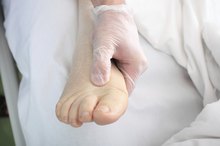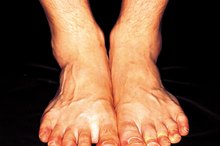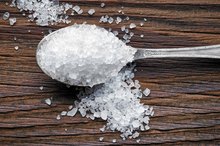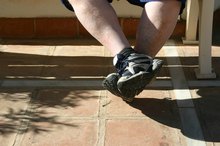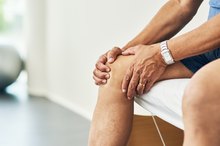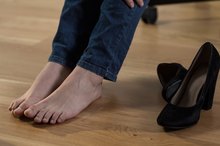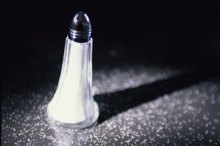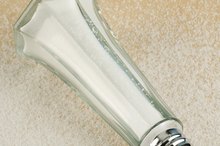What Can I Eat or Drink to Reduce Swelling in My Feet & Ankles?
A number of physiological processes, when interrupted, can lead to excessive fluid accumulating in the lower extremities like the feet and ankles. This fluid buildup is known as edema and may be the result of not only serious conditions like liver disease, renal failure and heart failure, but also healthy pregnancies, prolonged sitting and high-sodium diets. Associated medical conditions require consultation with a physician and treatment of the root causes of the swelling. As an adjunct, however, a number of dietary and lifestyle interventions can also help.
Tips
Help reduce edema or swelling in your feet and ankles by eating more fresh produce, avoiding high-sodium foods and exercising more. Talk to your doctor about treating the underlying causes of your edema.
Limit Excess Sodium
According to Harvard Health Publishing, "water follows sodium," so if sodium accumulates in the tissues, so will water 3. Therefore, limiting daily sodium intake can help with swelling. Foods that cause swelling in the legs can include high-sodium foods like canned or pickled foods, condiments, fast foods and other highly processed foods. The sodium content of foods at grocery stores may not be obvious, so it's good to read labels carefully and consume less-processed foods that include no more than five ingredients.
Read more: 10 Ways to Beat Belly Bloat
Consume Adequate Potassium
Is There a Natural Way to Get Rid of Fluid in the Body?
Learn More
There are also foods to reduce swollen feet and ankles. Consumption of potassium, a mineral that counterbalances sodium throughout cells in the body, can help reduce sodium and water retention. Foods high in potassium include bananas, spinach, avocados, navy beans and potatoes. Although a number of starchy foods are rich in potassium, they often come with a higher glycemic index that raises insulin levels, which in turn leads to sodium retention. Consume them in moderation.
According to the Harvard T.H [2](https://www.hsph.harvard.edu/nutritionsource/sodium-potassium-balance/ 'inline-reference::Harvard T.H. Chan School of Public Health: Shifting the Balance of Sodium and Potassium in Your Diet'). **Chan School of Public Health, the ideal foods are low in sodium, high in potassium and have a lower glycemic index 23. Harvard Health Publishing recommends at least 4,700 milligrams of potassium daily 3. As a note of caution, some medical conditions that cause foot swelling require limiting potassium levels and require physician consultation.**
Read more: What Is the Purpose of Potassium in the Human Body?
- There are also foods to reduce swollen feet and ankles.
- Consumption of potassium, a mineral that counterbalances sodium throughout cells in the body, can help reduce sodium and water retention that raises insulin levels, which in turn leads to sodium retention.
Home Remedies for Swollen Feet
Though a number of diuretic herbs can help with swelling, many fruits and vegetables are also diuretics. These include:
- asparagus
- parsley
- beets
- grapes
- green beans
- leafy greens
- pineapple
- pumpkin
- onions
- leeks
- garlic
Additional Home Remedies
Does Sodium and Potassium Imbalance Lead to Swollen Ankles?
Learn More
Dietary changes may not be enough to eliminate leg swelling and should be complemented with lifestyle changes and other interventions. Leg swelling is very common after prolonged sitting and immobilization. For instance, it's not unusual to observe swollen legs after a long flight.
To help remove fluid buildup, try walking around or, even better, engaging in daily exercise. This encourages blood flow back to the heart and drainage of the lymphatic system, which can serve as a reservoir of excess fluid. Raising the legs above the heart is also a great way to help drain fluid from the legs. Compressing the legs with compression stockings and massaging the legs toward the heart are also useful home remedies for swollen feet.
- Dietary changes may not be enough to eliminate leg swelling and should be complemented with lifestyle changes and other interventions.
- To help remove fluid buildup, try walking around or, even better, engaging in daily exercise.
Related Articles
References
- Journal of the American Society of Hypertension: Dietary Potassium: A Key Mediator of the Cardiovascular Response to Dietary Sodium Chloride
- Harvard T.H. Chan School of Public Health: Shifting the Balance of Sodium and Potassium in Your Diet
- Penn State's Hershey Medical Center: Edema
- Mayo Clinic: Glycemic Index Diet: What's Behind the Claims
- American Heart Association. Sources of Sodium.
- Centers for Disease Control and Prevention. Top 10 Sources of Sodium. 2017.
- Institute of Medicine. Dietary Reference Intakes Tables and Application. National Academies of Sciences, Engineering, and Medicine, Health and Medicine Division. 2015.
- United States Department of Agriculture. Dietary Guidelines for Americans 2015–2020. United States Department of Health and Human Services. 2015.
